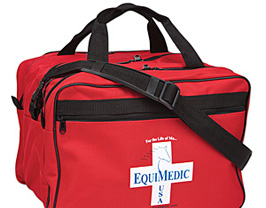
Despite their classic beauty and grace, most horses are prone to accidents. From small scratches to puncture wounds or strained muscles to broken legs, at times it seems like horses and ponies are magnets for trouble.
Worse, equine injuries can be just as common whether your horse is stalled or turned out to pasture. The best way to treat any injury, however, is to be prepared with a well-stocked, easily accessible first aid kit. In fact, keeping even a few of the below first aid essentials could help save a severely injured horse’s life while you wait for your veterinarian to arrive.
Vital first aid supplies
Every horse owner needs a few basic first aid essentials. These items will help you dress wounds, reduce swelling and inflammation, and more. In fact, since a horse injury can occur at any time or in any location, keep at least a basic first aid kit in your barn, truck or travel trailer, and saddle bag. Depending on your preference, wound care systems are available. Or, make your own kit with the following items:
* Bandages – protect wounds, support muscles, and hold ice packs with horse leg wraps or self-adhesive bandages, including CoFlex, PowerFlex, and Vetrap.
* Blunt-Tipped Scissors – safely cut away and remove bandages and wraps.
* Buckets – soak hooves and more with a few buckets kept specifically for first aid use.
* Flashlight – view wounds and injuries in darkness or poor light conditions.
* Hemostat – remove splinters, burrs, thistles, and more from your horse’s skin with a hemostat.
* Hoof Pick – remove foreign objects from hooves and shoes.
* Ice Packs – prevent and reduce swelling with Ice Cells.
* Lubricant – help insert thermometers with mineral oil or Vaseline®.
* PVC Pipes – cut 6″ diameter piping in half lengthwise and then into 1-1/2 to 2 foot sections for use as an emergency splint.
* Rubbing Alcohol – quickly disinfect scissors, thermometers, and more.
* Sheet or Roll Cotton – help apply pressure bandages or offer support to injured muscles or bones.
* Sterile Gauze – clean and cover minor cuts and wounds with sterile gauze or Telfa (non-stick) pads of various sizes. Use gauze rolls to hold dressings and pressure wraps in place.
* Surgical Gloves – keep your hands clean and help prevent wound contamination.
* Thermometer – measure your horse’s temperature (normal range is 99.0°F to 101°F) with a fast and accurate digital thermometer.
* Wire Cutters – free your horse from fences.
* Wound Antiseptic – prevent infections with an antiseptic powder or ointment. Some insect repellents, such as Roll-On Fly Repellent and SWAT® are designed for use around wounds to help repel insects for added wound protection.
* Wound Cleaner – clean fresh wounds with a gentle, iodine solution like Povidone-10%.
Easy access to your veterinarian’s and farrier’s contact information is also vital. In addition, a complete record of all your horse’s medications, vaccinations, and wormers is essential – especially in an emergency. The best way to track all this information is with your FREE Horse Health Record.
Helpful first aid extras
The best first aid kit holds a range of products to deal with a wide variety of injuries or accidents. In addition to the basics, however, having the following products accessible will help you further prepare for almost any mishap:
* Electrolytes – help hydrate your hard-working horse with an electrolyte paste.
* Eye Cleanser – flush away dirt and debris from sensitive eyes with Eye Clens® or Clear Eyes.
* Fly Mask – protect face wounds and eyes from insects.
* Hoof Boot – treat abscesses and sore feet with a convenient boot kit, such as the HOOFix Emergency Trail Boot.
* Medicated Shampoo – kill bacteria and fungi on your horse’s skin and coat with a iodine-based shampoo.
* Phenylbutazone – treat inflammation and manage muscle, joint, and bone pain with this non-steroidal pain medicine, available by prescription in paste or powder form from the Drs. Foster and Smith Pharmacy.
* Poultice – draw out infections, soothe sore muscles, and more with a poultice, such as Epsom Salt or Icetight.
* Tail Wrap – protect your horse’s tail and keep it out of your way with a tail bag.
* Twitch – keep your horse’s attention while wounds are tended with a twitch.
First aid tips
Accidents and injuries can turn even the calmest horse owner into a frazzled mess. But what your horse needs most when he suffers any injury or wound is for you to remain calm and focused on getting your horse the help he needs. Should you ever need to use your first aid kit, keep the following tips in mind:
* Stay Calm – you can better help your horse when you’re calm and collected.
* Call for Help – an additional pair of hands will get more done faster.
* Stay Safe – you won’t be able to help your horse if you get hurt trying to help him.
* Wash Your Hands – avoid contaminating any wound by first washing your hands and then wearing latex or rubber gloves.
When any injury occurs, the key is to act quickly and smartly. To best ensure your horse is on the road to recovery as fast as possible, know where your first aid kit is at all times. In fact, show anyone who has access to your barn, travel trailer, or vehicle where your first aid kit is located. Better yet, mark your first aid kit with a cross fashioned out of red tape or a bright red permanent marker – signaling its contents to everyone.
Drs. Foster & Smith Educational Staff